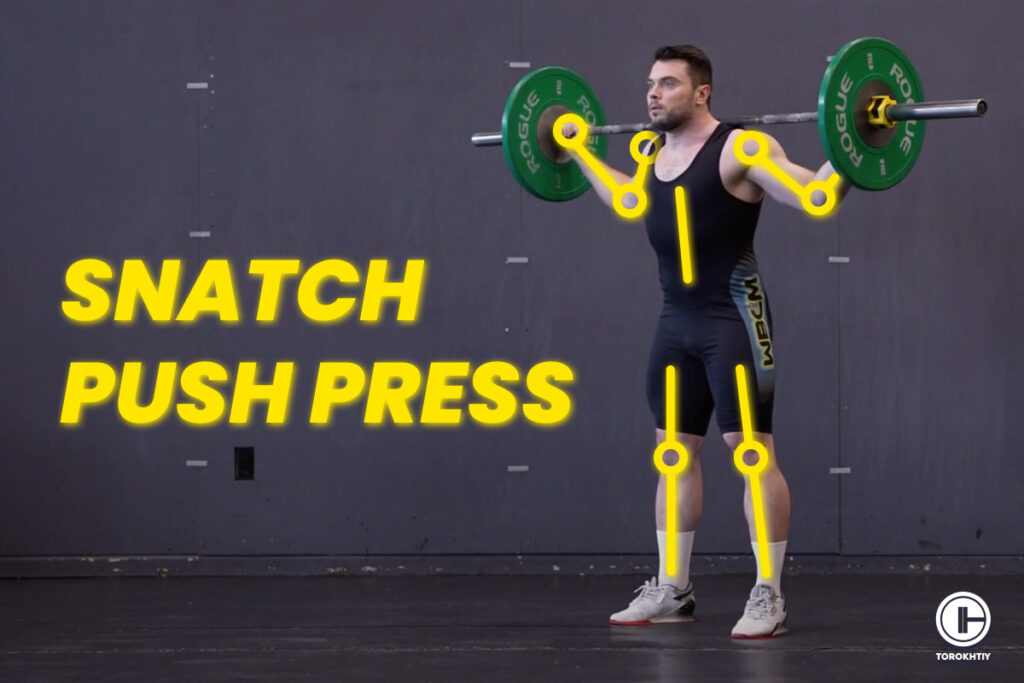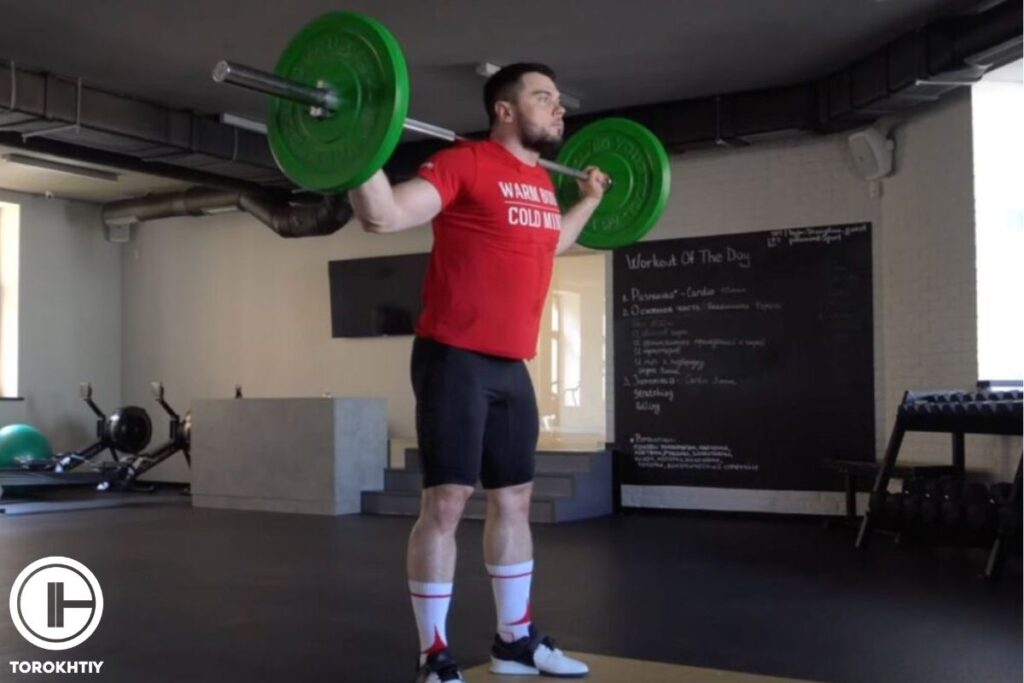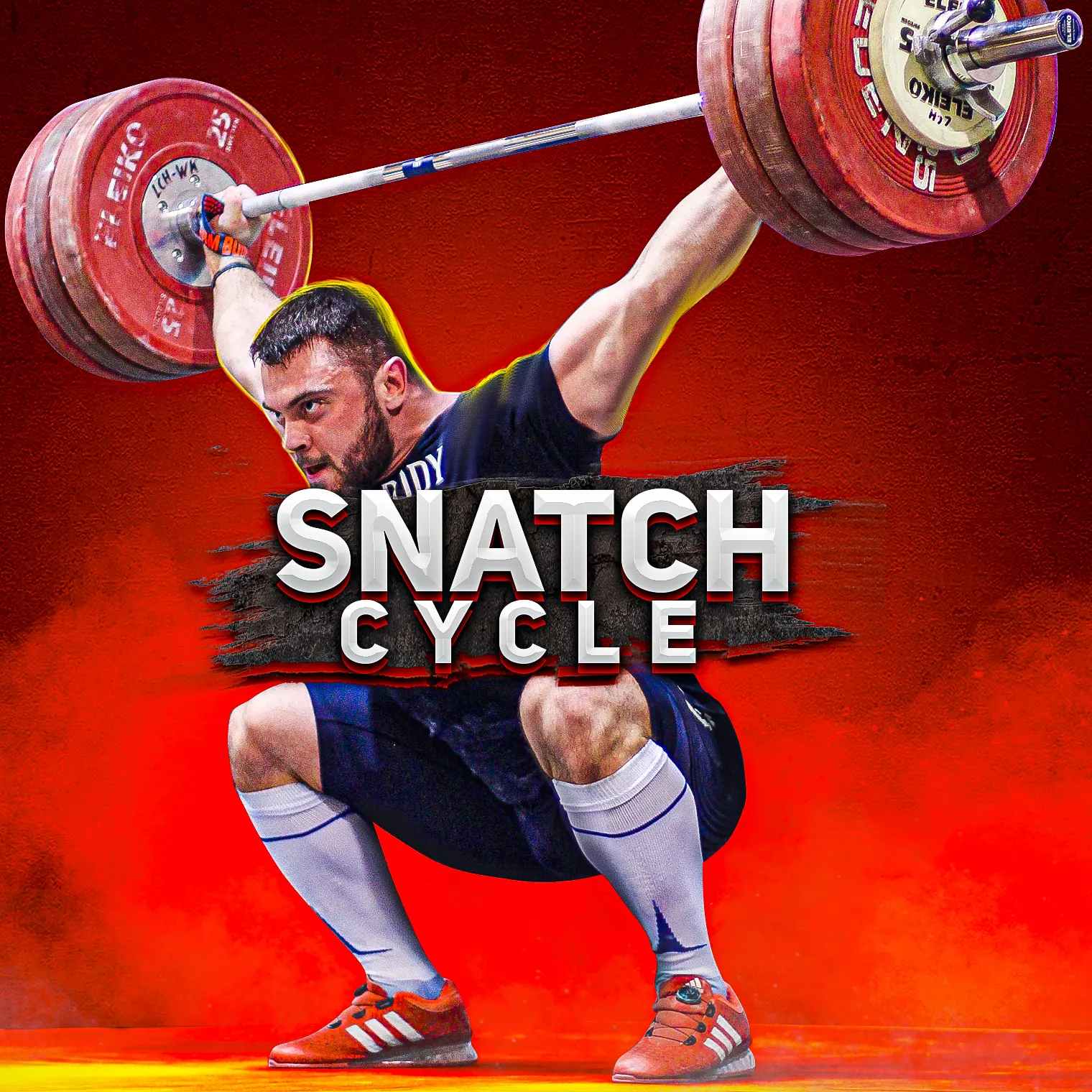Snatch Push Press: Technique, Benefits & Common Mistakes
Author:
Reviewed by:
(21 years of Oly Lifting experience)
Unlock your full potential by engaging with our experts and community! Have questions about your fitness journey or looking for expert advice on weightlifting techniques? Don’t hesitate — leave a comment below and Jacek Szymanowski will provide a personalized answer and insights to help you reach your goals.
Torokhtiy is reader-supported. Some links are affiliate links, and we may earn a commission at no extra cost to you. See our disclosure page for details.

What Is Snatch Push Press?
The snatch push press is a weightlifting exercise that combines elements of the snatch and push press. It is a variation of the traditional push press, which is a compound exercise that involves using the legs to drive a barbell overhead, while the arms and upper body provide additional power to complete the movement. Difference is – you are doing it with the Snatch grip.
How to Do the Snatch Push Press?
If you want the benefits, you have to do it correctly! Here’s how.
1. Setup
Place the bar on your upper traps, like you would if you were doing a back squat. Use a wide grip and make sure your hands are spaced evenly. Stand with your feet shoulder-width apart and keep your feet pointed out a little.
2. Dip and Drive
Bend your knees a little and push your hips back. Keep your torso upright and core engaged. Explosive drive through your feet to extend the knees and hips and generate upward momentum.

3. Press
As you extend, push the bar straight overhead. Focus on keeping the bar path vertical and moving in a straight line. Extend your arms fully and lock out the elbows.

4. Catch
Keep your hips and knees fully extended and make sure your body is straight and stable. Focus on keeping the bar in line with the middle fo your body, directly over your head. Engage your core and shoulders to stabilize the bar.

5. Reset
Lower the bar back to your upper traps in a controlled way and get ready for the next rep!
How to Program Snatch Push Press?
Beginner
- Sets: 3 sets
- Reps: 5-7 reps per set
- Frequency: Do the snatch push press 1 to 2 times a week
- Tips for progression: Your focus is mastering the form and technique so use an empty bar or very light weights. Increase the weight in 5-pound increments as your form improves
Intermediate
- Sets: 4 sets
- Reps: 3-5 reps per set
- Frequency: Do the snatch push press 2 to 3 times a week
- Tips for progression: Use the heaviest weights you can handle while maintaining good form and focus on explosiveness in the drive phase
Advanced
- Sets: 5 sets
- Reps: 2-4 reps per set
- Frequency: Do the snatch push press 2 to 3 times a week
- Tips for progression: Use weights that are close to 70-80% of your snatch max to build maximal strength and power. Emphasize speed and precision and consider using variations like pause snatch push presses or adding resistance bands and chains
Save it for easy access!
Bookmark this page now to access the program and instructional videos anytime, anywhere.
Stop wasting time searching during your gym sessions.
Muscles Worked by a Snatch Push Press
The snatch push press is a weightlifting exercise that primarily targets the muscles of the upper body, especially the shoulders and triceps. Specifically, the muscles that are primarily involved in the snatch push press include:
1. Deltoids
The deltoid muscles are the main muscles that are targeted during the snatch push press. They consist of three parts: the anterior deltoid, medial deltoid, and posterior deltoid, and all three parts are heavily involved in this snatch and press exercise.
2. Triceps
The triceps muscles are located on the back of the upper arm and are mainly responsible for extending the elbow. They are also heavily involved in the snatch pressing, especially during the lockout phase of the lift.
3. Upper Trapezius
The upper trapezius is a muscle located on the upper back and neck. One of its functions is to elevate and rotate the shoulder blades, which is an important movement during the snatch push press.
4. Core Muscles
The snatch push press also involves the use of the core muscles, including the abdominals and lower back muscles, to stabilize the body during the lift.
5. Leg Muscles
Although the primary focus of the snatch push press is on the upper body, the exercise also requires the use of the leg muscles, including the quads and glutes, to generate power and drive the weight upwards.

Who Should Do the Snatch Push Press?
The snatch push press is very versatile and has a lot of benefits. It’s especially useful for people who want to improve their snatch technique, build upper body strength, and improve explosive power.
1. Weightlifters
Weightlifters, especially those focusing on the snatch, can use the snatch push press to improve their overhead stability and strength. This exercise reinforces the correct overhead position, which is key to the successful snatch.

2. Beginners Learning the Snatch
People who are new to weightlifting can use the snatch push press as a foundational exercise to develop strength and coordination they’ll need for the snatch, It will allow them to practice the overhead position in a controlled manner.
3. Strength and Power Athletes
Athletes in sports like rugby, football, and track and field can benefit from the snatch push press because of its focus on explosive power. It will help develop the fast-twitch muscle fibers needed for powerful movements, which will translate into better performance.
Follow us!

Free!
Get a 2-week Weightlifting Program as a bonus for the subscription to kickstart your training plan!

Free!
6 Main Mistakes In Snatch Push Press Execution
The snatch push press is a complex weightlifting exercise that requires proper technique and form to perform safely and effectively. Here are some common mistakes to avoid when performing the snatch push press:
❌ Improper grip
The snatch push press requires a specific snatch grip that is wider than a regular overhead press grip. Using an incorrect grip can lead to inefficient technique, reduced overhead strength and stability, and increased risk of injury.
❌ Poor rack position
During the initial phase of the snatch push press, the barbell needs to be properly racked on the shoulders. Failing to rack the bar properly can result in an unstable position and reduce the transfer of power to the bar.
❌ Incorrect Timing
Timing is critical in the snatch push press, and failing to time the movements correctly can lead to a loss of power or even a missed lift. The dip should be slow and controlled while the drive should be fast and aggressive.
❌ Incomplete Lockout
Failing to fully lock out the arms at the top of the lift can lead to reduced power output and increase the risk of injury.
❌ Poor Footwork
Proper footwork is essential in the snatch push press, as it helps to generate power and maintain stability. Failing to keep the feet in the correct position can lead to a loss of balance and reduced power output.
❌ Lack of Mobility
The snatch push press requires good mobility in the shoulders, hips, and ankles. Failing to address mobility limitations can lead to inefficient technique and increased risk of injury.
It is good to work with a qualified coach or trainer to learn proper technique and avoid these and other potential mistakes when performing the snatch push press.
3 Snatch Push Press Variations
Sometimes athletes don’t have a barbell or just want to perform some variation of exercise they use to do all the time, just to get away from the common routine. Here are some variations of the snatch push press that you can incorporate into your training:
1. Dumbbell Or Kettlebell Push Press
This variation of the push press is performed with dumbbells or kettlebells instead of a barbell. This variation can help to develop more stability and control in the shoulders and arms.
2. Single Arm Dumbbell Or Kettlebell Push Press
The single arm push press is a unilateral exercise that is performed with one arm at a time. This variation can help to improve stability and balance on each side of the body.
3. Squat To Snatch Push Press
The squat to snatch push press also known as a snatch thruster is a complex exercise that combines the back squat and snatch push press movements. This variation can help to improve mobility, stability, and overall technique in the snatch movement.
It is important to master the basic snatch push press movement before attempting these variations, and to work with a qualified coach or trainer to ensure proper technique and form.
3 Snatch Push Press Alternatives
Here are some exercise you can do if you want more of a change from the snatch push press than variations offer, but you’re still after almost the same benefits.
1. Overhead Press
You press a barbell or dumbbells directly overhead from shoulder height. This exercise builds strength in the shoulders and triceps, which is important for stabilizing the bar in the snatch. This exercise is simpler and it’s good for developing raw pressing strength.
2. Push Press
The push press is done by using a slight dip od the knees and hips to generate momentum, then pressing the barbell overhead. It focuses on developing power and explosiveness in the legs and upper body.
3. Snatch Balance
It starts with the bar on your shoulders, which is followed by a quick dip and drive, where you drop under the bar into a snatch receiving position. It improves speed and coordination while reinforcing the stability you need in the overhead squat position.
Conclusion
The snatch push press is a fantastic exercise that will improve your explosive power, coordination, and strength in the full body. If you include it into your training routine, you can improve your overall snatch performance and develop the necessary muscle groups for effective overhead lifts. Plus, it can add variety to your workouts.
Remember to focus on proper technique, address any mobility issues, and the rest is practice.
How has the snatch push press improved your lifting performance? Which variation do you like the most and why? Have you faced any obstacles in learning the snatch push press and how have you managed to overcome them?
Share your experiences and tips in the comments below!
Also read:
References:
- Photos by Torokhtiy Media Team; decade3d, Canva.com.
Why Trust Us?
With over 20 years in Olympic weightlifting, strength training, nutrition coaching, and general fitness our team does its best to provide the audience with ultimate support and meet the needs and requirements of advanced athletes and professional lifters, as well as people who strive to open new opportunities and develop their physical capabilities with us.
By trusting the recommendations of our certified experts in coaching, nutrition, and sports training programming, as well as scientific consultants, and physiotherapists, we provide you with thorough, well-considered, and scientifically proven content. All the information given in the articles concerning workout programming, separate exercises, and athletic performance, in general, is based on verified data.
The product testing process is described in more detail here.
Author: Jacek Szymanowski
Certified Nutritionist,
M.Sc.Eng. Biotechnology
Performance Architect,
Strength and Conditioning Specialist
With over 30 years of fighting experience, specialization in nutrition coaching for athletes, and expertise in metabolic health and dietary strategies, Jacek offers a comprehensive approach to optimizing your performance and well-being. Backed by a Master of Science degree in Biotechnology, Jacek remains at the forefront of scientific advancements, ensuring that his coaching is always evidence-based and up-to-date.
Reviewed by: Oleksiy Torokhtiy
Olympic Weightlifting Champion, PhD in Sport Science
Best Results: Snatch – 200 kg,
C&J – 240 kg
Oleksiy Torokhtiy is a professional athlete boasting 20 years of experience in Olympic weightlifting. With multiple European and World titles under his belt, he has showcased his prowess in two Olympic Games (Beijing 2008 and London 2012). Upon concluding his illustrious career, Oleksiy dedicated himself to coaching. By 2022, he had conducted over 200 weightlifting seminars worldwide. He is the visionary behind an international sportswear and accessories brand known for its motto, “Warm Body Cold Mind.” Additionally, he is an esteemed author and the creator of a series of training programs and eBooks.





Still have questions after reading our article? Unlock your full potential by engaging with our experts and community! Don’t hesitate — leave a comment below and Jacek Szymanowski will provide a personalized answer and insights to help you reach your goals.